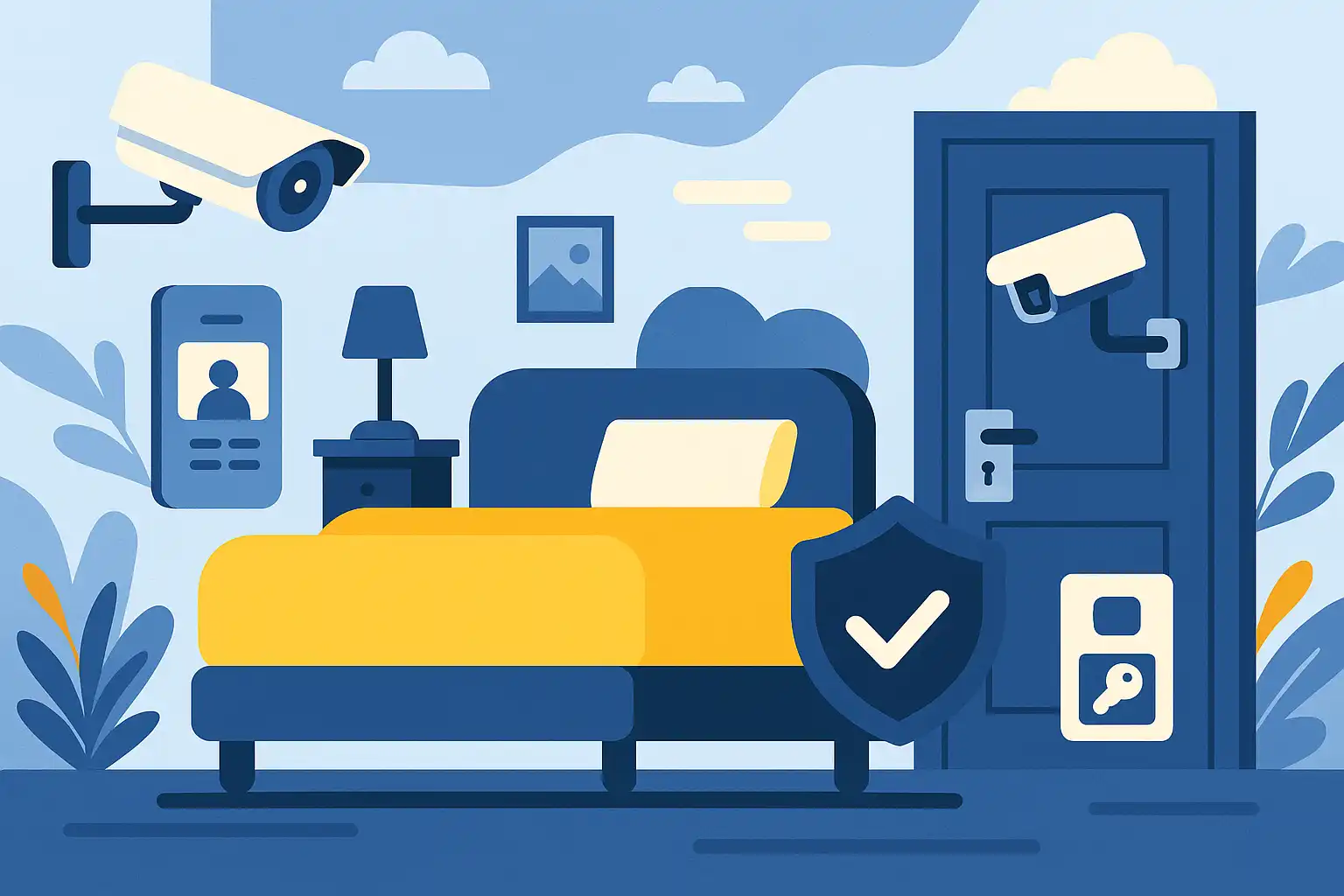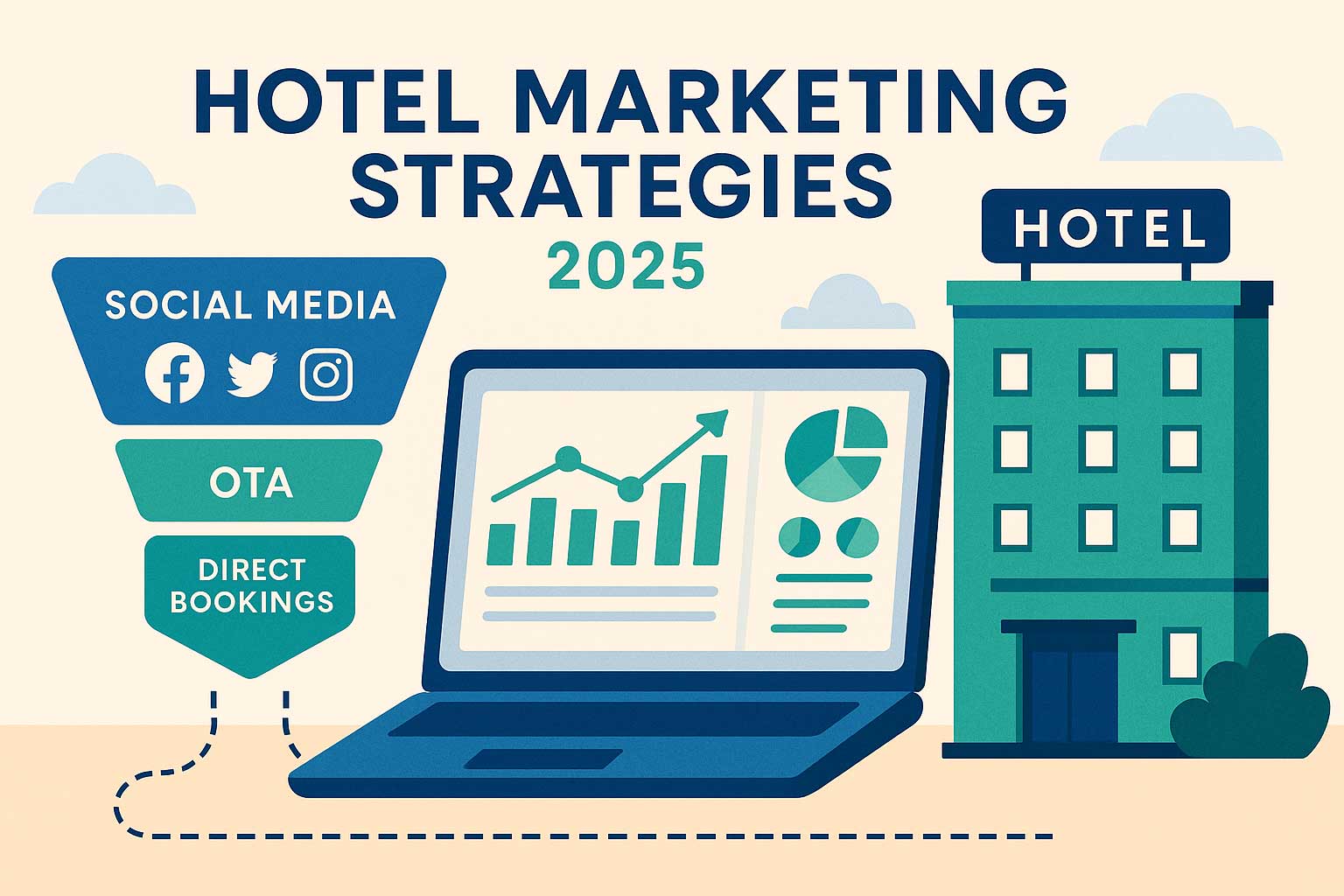Hotel Cost: Guide to Managing Hotel Expenses in 2025
Sep 2, 2025
 Mika Takahashi
Mika TakahashiPopular Categories
Hotel Technology & InnovationHotel Operations OptimizationDigital MarketingIndustry TrendsRevenue ManagementHospitality Industry
Popular Categories
Trending Post

Hotel Walk Letter Template: Professional Guest Communication

Online Travel Agents: What They Are and How They Work

Hotel Security Systems: Modern Protection Solutions

Hotel Advertising: Complete Guide to Boost Bookings and Revenue

25 Hotel Marketing Strategy Ideas for 2025: Complete Guide

AI Reservation Agent: Revolutionizing Hotel Booking and Guest Experience

PMS Communication: Streamlining Property Management Through Effective Guest Messaging
Table of contents
In today’s fast-paced and competitive hospitality world, knowing how to manage your hotel costs effectively can be the difference between thriving and just getting by. Since hotel operating costs often take up 65-80% of your total revenue, getting a handle on these expenses isn’t just smart—it’s absolutely necessary for keeping your business profitable and sustainable over the long haul.
Whether you’re a seasoned hotelier aiming to fine-tune your operations or just stepping into hotel management, this guide will walk you through key strategies and insights to help you control costs without sacrificing the guest experience. From smart labor management to leveraging the latest technology, we’ll cover all the essentials that influence your bottom line.
What Are Hotel Costs and Why They Matter
Simply put, hotel cost covers all the money you spend to build, run, and maintain your property. This includes everything from the big-ticket items like construction and pre-opening expenses to the day-to-day outlays such as staff wages, utilities, and guest amenities. Getting a clear picture of these costs is vital because they directly affect how you price your rooms and maintain healthy profit margins.
The importance of managing hotel costs becomes even clearer when you realize that most hotels operate on thin margins. Labor costs usually eat up 30-45% of your revenue, utilities take about 5-10%, maintenance runs around 3-5%, and marketing accounts for 2-5%. Even small improvements in how you handle these expenses can lead to noticeable boosts in profitability.

By managing costs effectively, hoteliers can make smarter decisions about pricing, staffing, and operations. This solid foundation supports revenue management systems that adjust pricing based on real time occupancy data and shifts in market demand. When hotel expenses are tracked and controlled well, your property can quickly respond to market changes and stay competitive, even during tough economic times.
Knowing your cost structure also opens the door to innovation and efficiency. Hotels that keep a close eye on their biggest expenses often find creative ways to cut costs without hurting the guest experience. This might mean adopting new hotel technology, rethinking operational workflows, or renegotiating supplier contracts to get better deals.
Primary Categories of Hotel Costs
Hotel expenses generally break down into two main types: fixed and variable. Fixed costs stay mostly the same no matter how full your hotel is—they include things like rent, insurance, software subscriptions, and salaries for permanent staff. Hotel variable costs, on the other hand, fluctuate with guest volume and cover utilities, housekeeping supplies, food and beverage, and hourly wages for on-call staff.
Understanding this distinction is key because it shapes how your hotel reacts to changes in demand. When occupancy dips, fixed costs still have to be paid, but variable costs can be adjusted to fit the lower guest numbers. This knowledge helps your management team make smart choices about pricing and resource allocation.
Cost structures can vary widely depending on your hotel’s size, location, and level of service. Luxury hotels usually have higher hotel fixed costs due to prime locations, extensive amenities, and more staff, while budget hotels tend to have higher variable costs as they focus on operational efficiency. Resorts might see unique cost patterns tied to seasonal demand and special amenities like spas or recreational facilities.
Seasonality adds another layer of complexity. Many hotels see big swings in revenue and expenses throughout the year. Understanding these trends helps with occupancy forecasts and allows you to adjust staffing, maintenance, and inventory purchasing to keep profitability steady across seasons.
Pre-Opening and Construction Costs
The biggest upfront investment in hotel development comes from pre-opening and construction costs. Land prices vary widely—from about $50,000 per room in secondary markets to over $500,000 in prime city locations—and this can shape the financial outlook for your project.
Construction costs for mid-scale to luxury hotels usually range between $200,000 and $600,000 per room, depending on local labor rates, materials, and design complexity. This covers everything from the building structure to mechanical systems and interior finishes, all while meeting local building codes. Good project management here can save you time and money.
Furniture, fixtures, and equipment (FF&E) typically make up 8-12% of your construction budget but have ongoing effects on operations. Choosing quality FF&E can lower maintenance costs and boost guest satisfaction, whereas poor choices might mean more frequent replacements and negative reviews. Smart FF&E planning also takes energy efficiency and staff convenience into account.
Pre-opening costs include recruiting and training staff, marketing, and working capital. These can add up to $10,000-$20,000 per room but are critical for a smooth launch. Thorough training helps get your team up to speed quickly, reducing hiccups that could affect early guest experiences.
Daily Operating Expenses
Day-to-day operating costs are the heart of ongoing hotel expense management. Staff wages and benefits usually represent the largest controllable expense, so balancing service quality with cost efficiency is essential. Scheduling staff based on occupancy forecasts helps keep labor costs in check while ensuring guests get the service they expect.
Utilities—electricity, water, gas, and telecom—are another big expense. Energy management systems can cut these costs by 15-25% through automated controls and monitoring. Water-saving programs, like towel and linen reuse, also help lower bills.

Managing housekeeping supplies and in-room amenities carefully is important to avoid waste while keeping standards high. Bulk buying and supplier negotiations can save money without compromising quality.
If your hotel includes food and beverage services, managing ingredient costs, portion sizes, and menu design becomes critical. Typically, food costs should be kept between 25-35%. Good inventory control and waste reduction are key to keeping your F&B department profitable.
Labor Cost Management Strategies
Labor costs, taking up 30-45% of hotel operating expenses, are a major focus for cost control. Understanding labor patterns and using flexible staffing can boost profits without sacrificing service quality. The goal is to align staffing with actual demand rather than sticking to fixed schedules.
Modern property management systems provide real time occupancy data, allowing you to staff dynamically based on reservations, walk-ins, and events. This approach can reduce labor costs by 10-15% while improving efficiency and guest service.
Cross training your staff is one of the best ways to optimize labor. When employees can cover multiple roles, you need fewer people overall but retain flexibility. Cross training also boosts job satisfaction and helps with employee retention, reducing recruitment costs.
Performance-based pay programs can motivate staff to focus on efficiency and guest satisfaction. Bonuses for productivity or cost-saving ideas encourage employees to contribute to your hotel’s financial health.
Staffing Optimization Techniques
Advanced property management systems go beyond basic scheduling by analyzing historical data, current bookings, and market trends to predict staffing needs. Integration with payroll helps track labor costs in real time against budgets.
Using part-time and on-call staff offers flexibility to handle demand swings without overstaffing. This works well in departments like housekeeping, where workload tracks occupancy. However, managing and training part-time staff requires careful attention.
Outsourcing certain services—laundry, landscaping, security, maintenance—can cut labor and administrative costs. Third-party providers often have economies of scale and let your team focus on guest-facing tasks that drive revenue and satisfaction.
Investing in employee retention pays off. Hiring and training new staff can cost $3,000-$5,000 per person, so keeping your team happy with good benefits and career growth opportunities is smart. Strong retention also means better service consistency and smoother operations.
Technology Solutions for Cost Reduction
Investing in hotel technology can slash costs while boosting efficiency and guest experience. Cloud-based property management systems reduce IT expenses and offer more features than old-school on-premise setups, eliminating the need for costly servers and maintenance.
Mobile check-in and check-out reduce front desk staffing needs during busy times and offer guests a smoother experience. These systems handle routine tasks like room assignments and payments, freeing your staff to provide personalized service. The savings often pay back the investment within a year or so.
Energy management tech is a top cost saver. Automated HVAC controls, occupancy sensors, and smart lighting can cut energy use by 15-25%. Plus, detailed data helps you spot more opportunities to save.
Revenue management software helps optimize pricing and inventory, analyzing market demand, competitor rates, and booking history to suggest the best room rates. While it’s mainly about boosting revenue, it also ensures your costs are covered while staying competitive.
Energy and Utility Cost Control
Switching to LED lighting is one of the quickest ways to save energy, cutting lighting electricity use by 50-70%. LEDs last longer too, reducing maintenance and labor costs. Many utilities offer rebates to sweeten the deal.
Smart HVAC systems with occupancy sensors adjust heating and cooling automatically, saving money when rooms are empty. These systems can also pre-condition rooms based on bookings, integrating with your property management system for smooth operation.

Water-saving fixtures and linen reuse programs help cut both utility bills and environmental impact. Educating guests about towel and sheet reuse can reduce laundry costs by 15-20%, appealing especially to eco-conscious travelers. Leak detection and water-efficient fixtures add ongoing savings with minimal guest disruption.
Energy audits by professionals can uncover quick wins and longer-term investment opportunities. Many utilities offer free or discounted audits to commercial customers.
Revenue Optimization to Offset Costs
While keeping costs down is critical, boosting revenue is just as important for profitability. Dynamic pricing based on demand forecasts and competitor pricing helps you capture the most revenue during busy periods while staying attractive in slower times.
Adding ancillary revenue streams beyond room sales—like spas, events, parking, and dining—can contribute 20-40% of total revenue in well-run hotels. These often have different cost structures, offering chances to improve overall margins.
Encouraging direct bookings reduces reliance on OTAs, which charge 15-25% commissions. Optimizing your website, booking engine, and offering incentives can increase direct bookings, which means more money stays with you.
Upselling and cross-selling train your team to spot chances to increase revenue per guest through upgrades, extra services, or longer stays. Though these programs require training, they can raise your average daily rate and total revenue. Some upselling can even be automated during online check-in.
Distribution Channel Cost Management
Balancing direct bookings with OTA channels means analyzing acquisition costs and guest lifetime value. OTAs bring volume and exposure but their commissions cut into profits. Successful hotels use exceptional service and targeted marketing to turn OTA guests into direct bookers.
Improving your website and booking engine—making them mobile-friendly, fast, clear, and easy to use—boosts conversion rates. Investing in professional design and ongoing tweaks usually pays off through more direct bookings and less commission paid out.
Social media and hotel content marketing are cost-effective ways to build brand awareness and encourage direct bookings. Sharing engaging content, guest stories, and behind-the-scenes glimpses helps build relationships that lead to repeat business. These organic channels often deliver better ROI than paid ads.
Automated email marketing lets you communicate with past and potential guests at low cost. Personalized campaigns based on guest preferences and booking history tend to convert better than generic promos.
Operational Efficiency Improvements
Preventive maintenance cuts emergency repair costs and extends asset life. Regular upkeep of HVAC, elevators, plumbing, and other systems prevents costly breakdowns that disrupt operations and annoy guests. Well-planned maintenance also boosts energy efficiency and guest satisfaction.
Inventory management systems reduce waste and storage costs while keeping supplies on hand. These tools track usage, automate reordering, and flag slow-moving items that tie up cash. Good inventory control prevents stockouts that hurt guest experience or force expensive last-minute buys.
Negotiating with vendors and bulk buying can save money across many expense categories. Regularly reviewing contracts and running competitive bids ensures you get fair prices. Long-term supplier relationships often offer better pricing and service than constantly switching vendors just to chase the lowest cost.
Quality control reduces costs tied to guest complaints, negative reviews, and service recovery. Consistent standards and staff training help prevent problems that require costly fixes. Investing in quality pays off through fewer complaints and happier guests.
Department-Specific Cost Controls
Improving housekeeping efficiency can lower labor costs and boost guest satisfaction. Streamlined cleaning routines, optimized supply carts, and smart room assignments cut cleaning time without sacrificing quality. Mobile communication tools help coordinate tasks and reduce time spent on routine work.
Food and beverage cost control involves portion management, menu design, and waste tracking. Successful F&B operations keep food costs between 25-35% through careful purchasing and preparation. Regular menu reviews help highlight high-margin items and identify those to tweak or drop.

Front office improvements focus on streamlining guest services while cutting labor needs. Technologies like mobile check-in, automated billing, and guest messaging handle routine tasks, letting desk staff focus on personalized service. Cross training front office staff adds operational flexibility.
Maintenance cost savings come from predictive maintenance tech, vendor partnerships, and smart capital planning. Sensors and data analysis spot potential equipment issues early, allowing planned repairs during low-impact times. Good vendor relationships secure priority service and better pricing.
Industry Trends and Future Challenges
Inflation keeps pushing hotel costs up in 2024-2025, especially labor, food, and utilities. Wage inflation of 5-10% is common, forcing hotels to balance higher pay with efficiency gains. Energy prices remain unpredictable due to global markets and supply chain issues.
Labor shortages continue to drive wage increases and operational challenges. Hotels respond with automation, better benefits, and new staffing models. Some redesign service delivery to need fewer staff while keeping guest satisfaction high. Cross training and multi-skilled employees are now essential.
Sustainability investments cost upfront but often save money long-term and attract guests. More travelers expect eco-friendly practices, and corporate clients increasingly require them. Green certifications can boost both savings and revenue in some markets.
Technology adoption is accelerating, with AI, automation, and data analytics becoming standard tools for cost management and revenue optimization. Still, tech investments must be carefully evaluated to ensure they pay off. The best implementations solve real problems rather than adopting tech for its own sake.
Cost Benchmarking and Performance Metrics
Key metrics like cost per occupied room (CPOR), labor cost percentages, and utility cost per square foot help track performance and spot improvement areas. Comparing these benchmarks against industry standards shows where you stand.
Costs vary widely by hotel type, location, and service level. Luxury hotels have higher absolute costs but often better profit margins thanks to premium pricing. Budget hotels focus on efficiency but must still meet guest expectations. Regular benchmarking guides strategic planning.

Monthly financial reviews and budget variance reports help spot trends and issues early. These reports show which cost areas are over budget and need attention. They also highlight seasonal patterns for better planning.
Competitive cost analysis helps you understand your market position and find improvement opportunities. Benchmarking against similar hotels or studying successful competitors’ cost structures can inform your strategies. Knowing your cost advantages helps with investment decisions.
Measuring ROI on cost-cutting projects ensures your efforts deliver real results. Tracking financial impact of tech, process changes, and efficiency programs helps prioritize future investments and proves the value of cost management.
Conclusion
Managing hotel costs well in 2024 means understanding all your expenses—from fixed costs like rent to variable ones tied to occupancy. Success comes from smart labor management, tech adoption, and operational efficiency, all while keeping your guests happy.
Hotels that see cost management as an ongoing strategy, not just a reaction to financial pressure, are the ones that thrive. By using technology, optimizing staffing, and monitoring performance, you can build a profitable, sustainable business that delivers great guest experiences.
As the industry evolves, balancing cost control with innovation and guest satisfaction will be key. The best hotels maximize revenue and cut unnecessary expenses, laying a strong foundation for long-term success.
Remember, good cost management isn’t about cutting corners that hurt guests—it’s about running your hotel in the smartest way possible to deliver value at every level. Start with the strategies that fit your property’s needs and keep refining your approach over time.
